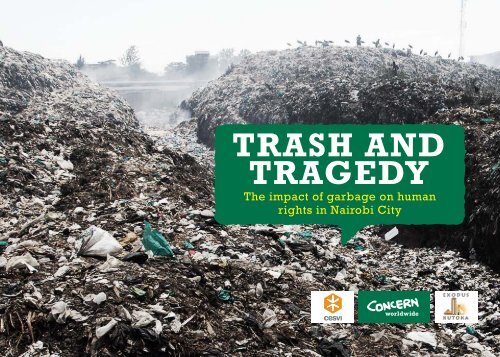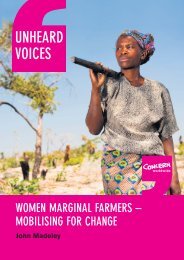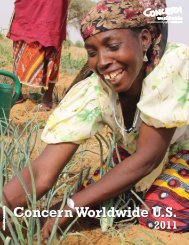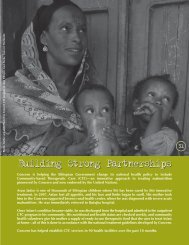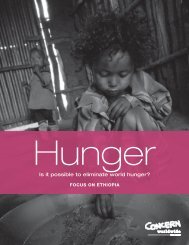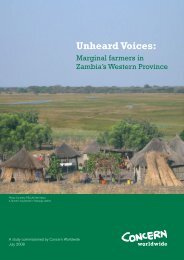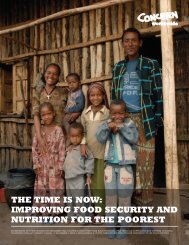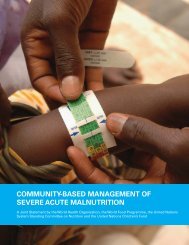TRASH AND TRAGEDY - Concern Worldwide
TRASH AND TRAGEDY - Concern Worldwide
TRASH AND TRAGEDY - Concern Worldwide
- No tags were found...
Create successful ePaper yourself
Turn your PDF publications into a flip-book with our unique Google optimized e-Paper software.
<strong>TRASH</strong> <strong>AND</strong><strong>TRAGEDY</strong>The impact of garbage on humanrights in Nairobi City1
Contents2Acknowledgements................................................ 4List of Abbreviations............................................... 7Executive Summary................................................ 8The Problem.................................................................... 13Case Study..................................................................... 20Legal and Policy Context.................................................. 21Fear of Exclusion..............................................................25Loss of Livelihood............................................................ 27A Green City.................................................................... 31Call to Action...................................................................3632.Google Earth Image
AcknowledgementsAcknowledgements...4We thank the 1,700 participantswho attended the variousdiscussion forums during theInformation Education andCommunication Campaign on the Health andEnvironmental Impact of Dandora MunicipalDumpsite between the 13th September 2011and 30th of June 2012. The 8 forums in whichthese discussion took place were facilitated bythe Environment Department of the Officeof the Prime Minister in partnership withKutoka Network, <strong>Concern</strong> <strong>Worldwide</strong> andCESVI. In addition, information and insightsof the Environment Department of the CityCouncil of Nairobi (CCN), United NationsEnvironmental Programme UNEP, KenyaAssociation of Manufacturers KAM and the JapanInternational Cooperation Agency (JICA) havebeen instrumental in the compilation of thisreport.Appreciation also goes out to all the diversespeakers and participants who attended thevarious stakeholder forums held during theyear; and who took time to send teams toresearch, prepare and share valuable andinformed presentations. Without them, the muchneeded insight on the Dandora Dumpsite andthe recommendations of this report would notbe possible.This report is dedicated to the communitieswhose human rights are jeopardized bythe environmental disaster that is DandoraDumpsite.Anne O’Mahony5Country Director<strong>Concern</strong> <strong>Worldwide</strong>
Written by Victor J. OderoList of AbbreviationsPhotography by:Manyara KinotiCCNCity Council of NairobiCESVI & Fulvio ZubianiCESVI Cooperation and DevelopmentCSOCivil Society OrganisationsCSRCorporate Social ResponsibilityEKKExodus Kutoka NetworkISWM Integrated Solid Waste ManagementKAMKenya Association of ManufacturersLALocal AuthoritiesMOEMinistry of Environment6 7NCBDNGONairobi Central Business DistrictNon Governmental OrganisationOPMOffice of the Prime MinisterPMPrime MinisterPPMParts Per MillionPPPPrivate Public PartnershipSWOT Strengths, Weaknesses, Opportunities and ThreatsISWM Integrated Solid Waste ManagementUNUnited NationsLayout & Design byUNEPUnited Nations Environmental ProgrammeWFCL Worst Forms of Child LabourJICAJapan International Cooperation Agencywww.good.co.ke
Executive SummaryExecutive Summary...8Aclean environment is essential tohuman health; however, cleaningoperations generate waste thatcan adversely affect human rightsif inappropriately disposed. While the poorare responsible for a small fraction of wastegenerated in the city, they bare the greatestburden of effects. Absence of a functional wastemanagement system in Nairobi has resulted inindiscriminate dumping of waste in Dandora,one of the poorest neighborhoods in the city.Evidence from these neighborhoodsdemonstrates that contamination from thedumpsite has adversely affected human health,particularly through respiratory diseases,endocrine complications and cancer. At leasthalf the children in surrounding neighborhoodshave heavy metal concentrations in their bloodthat exceed the maximum level set by theWorld Health Organization. Despite these risks,between 6000 and 10000 people make a livingfrom the dumpsite, while over 200,000 peoplehave indirect economic and social links to it.Consequently, many around the dumpsite do notwant it removed for fear of losing its benefits.City Council of Nairobi was to decommissionthe dumpsite in early 2012, after 8 years ofplanning. However, conflict between the counciland the Kenya Airports Authority over therelocation of the dumpsite to Ruai has broughtthe process to a grinding halt. The resultingstalemate implies there will be no quick end toone of the largest and most flagrant violationsof human rights in the country. The dumpsiteexists in contravention of several provisions ofthe Constitution of Kenya, and a raft of Laws andCourt Judgments.Given the gravity and extent of human rightsviolation, decommissioning of the dumpsiteshould be a matter of National Interest, andcertainly a priority for the County Government.However, public participation must be at thecore of this process to ensure the poor arenot buttressed further into extreme poverty.In particular, livelihood and decent workopportunities in the waste sector should becreated.To address this tragedy and injustice, the countygovernment should immediately deploy moderntechnology to isolate the toxic waste from contactwith people and the environment. Identificationof a site for construction of a sanitary landfill iscritical to a sustainable solution. However, forreal change to happen, residents of the Nairobimust take responsibility for their waste, a keystep is to demand urgent delivery of a safe andcomprehensive waste management system, witha functional sanitary landfill.9
4230 acres8 km. from the city103.5MResidents generate600geveryday11
The ProblemThe Problem...12Adecade ago the dumpsite wasdeclared full, yet today it is still theonly dumpsite serving Nairobi’s3.5 million inhabitants. With eachperson producing an estimated 600 grams ofsolid waste daily, at least 850 tones are depositedthere each day. What was once an abandonedlimestone pit is now a mountain of decayingdomestic, industrial, medical and agriculturalrefuse.The waste has polluted the soil, water and airdirectly affecting more than 200,000 peoplein surrounding settlements of Korogocho,Babadogo, lucky Summer, and Dandora. Thesepoor communities, while contributing the leastto the problem, are bearing the burden of anenvironmental catastrophe. The most affectedare between 6,000 and 10,000 persons whoscavenge at the site. These men, women andchildren, commonly referred to as ‘Chokora’,brave the dangers of the dumpsite to escape theravages of extreme poverty.Scavenging involves sorting and recovery offood and recyclable or reusable materials forsale. At least 15,000 tonnes of recoverable wasteis produced from the city each day, however, asthe city lacks sorting facilities, it is all dumpedat the site. Recovery is done manually throughlaborious processes involving poorly equippedand protected individuals working in smallgroups. These workers make meager income atgreat expense to their health.Over 150 waste workers drawn from over 50 self-help groups and cooperatives operating in thedumpsite participated in the forums. Each workerknows a friend or relative recently deceased asa consequence of disease or injury sustainedat the dumpsite. Infections, particularly of therespiratory tract, are a common cause of death.At least 25% of the workers had fresh injuriesas a result of accidents from scrap metals andtoxic waste. Accidental encounters with the‘Boiler’, referring to disused contaminatedindustrial waste barrels, are a leading cause ofinjuries and limb amputations. These accountsare corroborated by hospital records fromKariobangi Catholic Mission Clinic where andaverage of 9000 cases of respiratory infectionswere treated annually between 2009 and 2011.The African Network for the Protection andPrevention of children Against Child Abuseand Neglect, ANPCAAN, reports at least 53%of the children and youth at the dumpsite haverespiratory tract infections, coughs and asthma.More than half of children around the dumpsitehave blood lead level above 10 micrograms perdecilitre of blood, indicating exposure to highlevels of lead (UNEP 2007). The hematologicalsystems of these children are also reported assuppressed, with 12.5% having haemoglobinlevels below the normal ranges. A popular mythamong communities around the dumpsite is thatKenyatta National Hospital has a ward dedicatedto treating chest infections from Dandora andKorogocho.Scientific studies have long demonstratedthe link between unregulated dumping andnegative health outcomes in neighbouringcommunities. People absorb toxins like PCBs,Dioxins and Furans by inhalation, ingestion andabsorption through the skin. These elements13
The Problem...14cause digestive disruption, low IQ scoresand cancer. Anecdotal evidence from thecommunity suggests a high prevalence of healthcomplications emanating from the dumpsite.Anaemia, nervous system dysfunction, frailty,hypertension, kidney problems, decreasedfertility, frequent miscarriages, low birth weightand premature deliveries, were reported indiscussions with communities and workers atthe dumpsite.The more vulnerable community membersare even worse off. Of the estimated 10,000workers at the dumpsite, ANPPCAN reportsthat 55% are children below 18 years of age,some as young as young 10 years. Over 65%of children at the dumpsite are of school goingage. Almost all (95%) work to complement theirparents’ or families’ meager income; whilea significant proportion (78%) scavenge forfood. The number of children at the dumpsite isincreasing rapidly: ANPCAAN reported 18% ofchildren have been on the dumpsite for less than6 months. Notwithstanding loss of education,the majority of the children (69%) cannot meettheir basic needs, and experience irreparabledamage to their health. Children are also forcedto supplement income through illicit activitiesinvolving selling drugs, prostitution and otherforms of crime.Over 70% of the youth and children at thedumpsite have experienced various forms ofabuse at the hands of gangs, most (71.4%) bybusinessmen, and almost all 91.6% by theirpeers. The research indicates that parentalinvolvement in waste work is the most significantdeterminant of child labour at the dumpsite.15
“At least 53% ofchildren andyouth at thedumpsite haverespiratory tractinfections, coughsand asthma“1617
CASE STUDYWanjiku’s Story18In February 2012, Agnes Wanjiku, a former child labourer at the dumpsite, made nationalheadlines by remarkably scoring 363 marks out of a possible 500 in her Kenya Certificate ofPrimary Education (KCPE) exam. This feat earned her admission and full scholarship at a leadingsecondary school. Without the dumpsite, it would not be possible for her family to provide foodand support her to succeed in her exam.19However, Wanjiku is an exception; majority of the children in the dumpsite will not even attendschool, let alone obtain a scholarship. Yet her story exemplifies the paradox of life at the dumpsite.While it is a means by which many realize basic existence, it has entrapped the most vulnerablein an unhealthy existence. While it is true that fewer children sleep hungry in Korogocho andDandora because their families make a living from the dumpsite, it is also true that most willsuffer adverse and irreversible damage to their health and development. Only a precious few,like Wanjiku, will break free from the clutches of extreme poverty.
Legal and Policy ContextLegal and Policy Context...20The promulgation of the Constitution ofKenya in 2010, with express provisionof the Right to a Clean and SafeEnvironment, vindicated decadesof demands by communities affected by thedumpsite. The Constitution stipulates that theenvironment is to be protected for the benefitof present and future generations, particularlythrough the elimination of processes andactivities that are likely to degrade theenvironment. To the extent that unregulateddumping continues in Dandora, an illegalitypersists. The constitutional responsibility of theState to regulate use of land in the interest ofpublic safety and health is failing; moreover,dumping of waste at Dandora amounts toselective exposure of affected populations to anenvironmental hazard, which violates the rightto protection and equal benefit of the law.The dumpsite falls foul of a several legalprovisions:The Local Government Act, section 201,confers legal responsibility of solid wastemanagement to the City Council of Nairobi.The Council, in 2007, instituted a raft of solidwaste by-laws to regulate the management ofsolid waste, wherein the council affirmed itsresponsibility to collect, treat and dispose of,or otherwise deal with, all domestic waste andother litter generated within its jurisdiction. Thecouncil has failed to maintain this commitment.The Public Health Act provides that theCouncil has to employ all lawful, necessaryandreasonably practicable measures to keep theirjurisdiction clean and sanitary to preventoccurrence of nuisance or conditions liable tobe injurious or dangerous to human health. TheCouncil has failed to honour this obligation.The Environmental Management andCoordination Act EMCA (1999), explicitlyprohibits discharge or disposal of any wastein a manner likely to cause pollution to theenvironment or ill health to any person. TheAct prohibits, inter alia, disposal of waste atany site not established in accordance with alicense issued by the Authority. Moreover, theAct prohibits disposal of toxic waste into or neara water resource or the atmosphere.Human rights cannot be secured in a degradedor polluted environment. Environmentalconditions essentially determine the extent towhich people enjoy their basic rights to life,health, adequate food and shelter. Exposure ofpopulations to toxic waste is manifest derogationof the state obligation to respect, protect andfulfill human rights.The City Council of Nairobi (and thereafter theCounty Government, after the general elections),the National Environment Management Authority(NEMA) and the Ministries responsible for localgovernment and the Nairobi metropolitan bearthe legal responsibility for the ongoing violationof human rights at the dumpsite.21
“Over 200,000 people have closeeconomic and social ties with“the dumpsite22850tonnesdeposited everyday23
Fear of ExclusionFear of Exclusion...24Despite the serious human rightsand environmental concerns aboutthe dumpsite, there is little publicoutcry among city residents. This isprimarily because the dumpsite is situated onthe periphery of the central business district,and out of sight for most. In addition, informationabout the dumpsite and the proposeddecommissioning process remains outside thepublic domain. Only communities living aroundthe dumpsite are aware of its effects, but theytoo are kept in the dark about the formal plansto decommission the site.Failure to publicize the negative impact ofthe dumpsite has kept public demand forredress low. Moreover, it has also fosteredpublic mistrust and dissent towards thedecommissioning process, particularly amongcommunities and waste workers. Waste workershave affirmed that they will not accept closure ofthe dumpsite at the expense of their livelihoods.No information is publicly available about howdependents of the site will be incorporated intothe decommissioning process.Fear is also expressed by the indirectdependents of the dumpsite, who have closesocial and economic ties with waste workers.Through empathy or sympathy, communities,particularly in Korogocho, are unwilling tosupport any initiative without viable economicalternatives for solid waste workers, as it wouldtransfer the economic and social burden to them.The resulting misapprehension has underminedpublic confidence in the decommissioningprocess, despite the promise of improved livingconditions.The situation is exacerbated by disjointedand anti-poor policy positions emanating fromthe Government. For example, in late 2011,the government issued a statement throughthe Government Spokesperson in which it wasstated that “after substantive consultations” withthe stakeholders, the government was closingthe dumpsite due to “massive environmentaldegradation.” The news was met by sharpreactions from dependents of the dumpsite whotook to the streets in protest. The protesterswere particularly vexed by the spokesperson ‘sassertion that the workers were a “shameful lotof scavengers who were trying hard to destroyour environment.”In the absence of information, anti-poorstatements emanating from governmentonly serve to confirm the suspicions of poorcommunities that they will not benefit fromthe decomissioning of the dumpsite. Thishas also provided fodder for antagonistsof the decommissioning who have ralliedcommunities against the process. Most of theanti-decomissioning forces have deeply vestedbusiness interests that thrive in the prevailingchaos.25
Loss of LivelihoodWaste Workers Forum in Korogocho26Notwithstanding the public mistrustand skepticism at community level,there is insufficient informationabout the extent to which livelihoodsthat have depended on the dumpsite will beprotected. It is unclear the extent to whichthe project budget makes provision for therestoration and rehabilitation of livelihoodsthat will be lost when the dumpsite isdecommissioned.and livelihood opportunities for solid wasteworkers. Communities fear a decommissioneddumpsite will only create new opportunities formiddle and high income segments of society.The fear is that academic and skills criteriawill be used to preclude them from the newsolid waste economy. Unless communities areinformed and supported to adapt to improvedsolid waste management practices, their fearsof marginalization will become a reality.27It is widely reported that decommissioningwill cost KES 5.4 billion, to be funded throughdevelopment assistance grants. The extent anddetail about the grant conditions are scarceand outside the public domain. Consequently,fear abounds that no investments have beenproposed for the creation of decent workThere is compelling evidence that human capitalis abundant around the dumpsite, even by thefact that between 6,000 and 10,000 households,already derive an income from the site.Initiatives by Non-Governmental organizationshave demonstrated that this potential canbe used to transform lives. In 2011, a pilot
Loss of Livelihood...Loss of Livelihood...28programme by <strong>Concern</strong> <strong>Worldwide</strong> and KutokaNetwork supported 100 solid waste workers toimprove their livelihoods by granting workersKES 20,000 and by providing vocational skillstraining.The project aimed to establish safer and moreproductive livelihoods for solid waste workers.Participants were encouraged to build ontheir existing skills and practice, with a focuson decent work. The most preferred activitiesamong the participants were the manufacturingof charcoal from recycled material, tradingin scrap metal or plastics and small-scaleagriculture. After twelve months, 60% of thebusinesses established through the grantsremained in operation, with profits averaging30%. Participants who augmented existingcapital, realised returns as high as 125%. About30% of the participants did not make profit,while only 10% failed.Such programmes have demonstrated thatinvestment in waste workers and wasterelated businesses can positively transformthe livelihoods of the poor. This potentialremains unexploited in Nairobi city, whereonly 3 metric tonnes of solid waste is recycledfrom an estimated 15,000 metric tons createddaily. With adequate investment, solid wastehas the potential to create decent livelihoodsfor thousands of individuals. Increased andsystematic collection of solid waste, as plannedin the ISWMP, could significantly enhancelivelihood opportunities for the poor byenhancing the efficiency and scale of recyclingbusinesses.Ksh120000100000800006000040000200000InvestmentReturns from Grants to Solid Waste WorkersKsh4000035000300002500020000150001000050000Charcoal MakingRecruitmentRevenueInvestment22500ProfitScrap TradingRecruitmentKshRevenue1000080006000400020000Investment7200ProfitChicken FarmingRecruitmentRevenue3000Profit29
A green city30It is unclear what purpose thedecommissioned dumpsite will be put.Media reports suggest that the site maybe converted into a recreational park oran energy plant. However there are conflictingviews from various agencies about the best usefor the land. While the City Council of Nairobidoes not consider it feasible to extract naturalgas from the dumpsite, the Kenya ElectricityGenerating Company (KENGEN) announcedin 2011 that it planned to create 50 megawattsof electricity from the rehabilitated site byinvesting KES 9 billion. Private sector firmslike Multriwell, have confirmed that they havethe capacity to profitably generate energy fromnatural gas at the dumpsite.At forums, representatives of the privatesector expressed optimism on both electricitygeneration and carbon trading based on arehabilitated dumpsite. They demonstrated thatbased on a model (capacity of 2 metric tonnes,a total area of 20 ha, height of 15m, achieveddensity of 0.65 ton/m3 and calorific value ofLFG at 20 MJ/m3), Dandora dumpsite has thepotential to produce green energy at a priceof 0.027 €/kWh (Multriwell). In addition toincreasing the capacity of the national grid, thistechnology can contribute to carbon credits.Projects resulting in the reduction of greenhousegas emissions, (like renewable energy, energy31
32Calculation of Energy Potential of the DumpsiteLandfill gasproduction (20 years)Electricity production(40% efficiency)156,657 €2.97m3 MWh4,300,000 Kshs/kWh138,800,000efficiency, and afforestation) can earn valuablecarbon credits through the Clean DevelopmentMechanism (CDM) - a project led by UNEP. Therevenue generated from selling these CDMcredits (CERs) makes projects that otherwisewould not have been undertaken feasible.Emissions Trading prescribes that CERs canbe used by companies in the EU to meet theiremission targets, as long as the project thatdelivers the CERs is registered as a CDMproject, before 1 January 2013.Realisation CostElectricity CostsIn November 2011, it was widely reportedin the press that the City Council of Nairobiannounced an international tender worth KES600 million to convert the Dandora Dumpsiteinto a recreational park. The outcome of thisprocess is unreported and it remains unclear ifthis would preclude natural gas harvesting.Whether the land is to be converted into arecreational park or a natural gas plant, it isunclear how either will directly benefit the poor.An analysis of the two options, suggests thatunless affirmative action is taken to protect theinterests of the poor, they may not immediatelybenefit. With only 18 percent of slum dwellers’houses connected to electricity in Korogocho,compared to 60 percent in the rest of Nairobi,electricity generated from a gas plant would notbe useful to the community unless it is offeredat subsidized rates and prioritised for thesepoor communities.Korogocho is one of the most congested areasin Nairobi, with over 250 dwelling units perhectare. Most houses are constructed of earth,timber and waste tin cans. A recreational parkwould be at odds with the need for land andhousing.“55% of the 10,000workers are children -enough to fill more than110 class rooms!“33
MODEL FOR THE CONVERSION OF A DUMPSITE INTO A SANITARY L<strong>AND</strong>FILL3435
Call to ActionCall to Action...36Despite the gravity of thedisaster at Dandora Dumpsite,authorities appear to be impededby bureaucracy and politicalapathy. The sudden conflict between KenyaAirports Authority and the City Council ofNairobi, despite eight years of planning andconsultation, demonstrates the absence ofrequisite coordination and leadership. The KAAobjection to placing a new dumpsite adjacent tothe airport has sounded the death knell for thedecommissioning process. A new location for alandfill has now to be found by the City Councilof Nairobi.Even if the plans for the Ruai site had goneahead, the decommissioning process would notbe complete before 2016. It therefore appearshuman rights in Dandora are to be abrogatedindefinitely, a position that is untenable underthe new Constitution of Kenya.To redress the situation the following actions areurgently required:1. The City Council of Nairobi (thereafterCounty Government) should work withthe private sector to urgently deploytechnologies that isolate the waste at thedumpsite from the environment. This iscritical to averting further human sufferingand environmental degradation.2. The City Council of Nairobi (thereafterCounty Government) should immediatelyallocate land for a sanitary landfill. Dandorasite is not sustainable, as it lacks thefundamental qualities of a sanitary landfill,which isolates waste from the environment.3. The County and National governmentsand developement agencies shoulddedicate resources for the rehabilitation oflivelihoods and social protection for affectedcommunities. The Ministries responsiblefor Labour and Social Development shouldestablish programmes that support affectedworkers and vulnerable groups to findalternative sources of income.4. The County Government and Civil SocietyOrganisations should undertake awarenessraising and education campaigns totransform solid waste disposal behaviorin Nairobi City. A culture of solid wastereduction, reuse and recycling is thebackbone of a long term solution to thedisaster in Dandora.5. A formal institution comprisingstakeholder representatives should beconstituted and resourced to oversee thedecommissioning process. This institutionwill provide leadership by enhancingpublic participation, transparency andaccountability, which are currently lacking.Given the transition towards devolvedgovernment it is critical for a multistakeholder institution to co-ordinate themultiplicity of actors to be involved in theprocess.37
3839
40Working with the world’spoorest people to transform their liveswww.concern.netOFFICE OF THE PRIME MINISTER<strong>Concern</strong> <strong>Worldwide</strong> and Cesviare members of Alliance 2015


